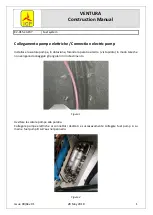
MAULE AEROSPACE TECHNOLOGY, INC.
MAINTENANCE MANUAL
FOR
MXT-7-160
Rev. E
27/39
13. Reinstall wheel.
Install axle nut and torque as follows: Rotate wheel-tire while tightening axle
nut to 150-200 in.-lb. to seat the bearing. Back off axle nut to zero torque. Tighten axle nut
to 30-40 in.-lb. while rotating wheel-tire. Rotate axle nut (CW or CCW) to align nearest axle
nut hole with axle slot. Insert axle nut retainer spring fully into axle slot and ensure engage-
ment with holes in axle nut.
14. Inflate tire to 35 psi to seat tire on rims and back off to 27-34 psi normal pressure. (16-18 psi
for oversize tires.)
15. Thoroughly inspect landing gear and axle; check that axle attach bolts are torqued to 90 in.-
lb. (dry).
16. Inspect brake pads. Replace if necessary.
17. Reinstall brake calipers and hubcap.
BRAKE CYLINDERS:
The hydraulic brakes are actuated by two (2) master cylinders, Maule P/N 4046B, on the left
side, and two (2) slave cylinders on the right side.
Check hydraulic oil level in master brake cylinders, proper level is no closer than ¼ inch to
top of cylinder. Add oil, if needed.
Bleeding brake system may be done as follows:
1.
Fill reservoir if necessary.
2.
Replace plug in reservoir.
3.
Connect a clear plastic tube to the bleeder valve with the free end of the tube in a container
of hydraulic brake fluid.
4.
Actuate brake pedal full stroke with the bleeder valve open which will force fluid into the re-
ceptacle where a check can be made for escaping air bubbles. Continue to actuate pedal
until no more air bubbles are observed.
5.
When no bubbles are observed, close the bleeder valve after pedal has returned to “off” po-
sition. Remove the plastic tube.
6.
Recheck reservoir level and fill as necessary.
Parking brake control system inspection and adjusting instructions:
1.
Release parking brake control (PULL-ON) and push pedals to release locks. Make sure the
cable that is attached to the locking levers has no interference throughout full operating
range of the parking brake control.
2.
Operate the rudder pedals though their full range of travel and check for any interference of
control cable and ensure that the locks do not engage. If any hang-ups occur, adjust per fol-
lowing Steps 3, 4, and 5.













































